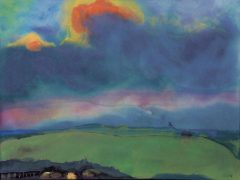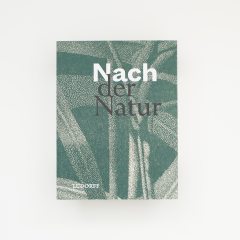Martin & Brigitte Matschinsky-Denninghoff
Regenbaum II
1988

brass and tin
base: 45 × 30 cm | 17 3/4 × 11 3/4 in
h (incl. base): 42.2 cm | 16 2/3 in
Dated »88«, (mistakenly) titled »Renbaum II« and marked »M-D« and »WV 600« on the bottom
Edition of Unique
Catalogue Raisonné by Költzsch/Schwarz 1992 no. 600
The artists’ studio; Galerie Gertrud Dorn, Stuttgart (1992); Private Collection Stuttgart
- Galerie Ludorff, "Nach der Natur", Dusseldorf 2017
- Galerie Ludorff, "Nach der Natur", Dusseldorf 2017, p. 52
- Georg W. Költzsch (Hg.), "Matschinsky-Denninghoff, Monographie und Werkverzeichnis der Skulpturen", Köln 1992, no. 600
The metal sculptures of the Matschinsky-Denninghoff couple take up the space surrounding them in almost unlimited and arbitrarily variable dimensions and formats. The dynamically dissolved, plastic bodies are always subject to a technical and formal-aesthetic law or regularity that has been consolidated over the years. They form their own spaces in which they unfold and with which they seem to enter into an indissoluble symbiosis. Since 1955, the year of their wedding, the metal sculptures by Brigitte Meier-Denninghoff and Martin Matschinsky, composed of line, rod and tube, have opened up haunting views and moving views.
Brigitte Meier-Denninghoff postulated early on that she could approach her understanding of nature not through scientific teachings, but solely through art.1 After her studies in Berlin and Munich, she assisted the English sculptor Henry Moore from 1948 and became co-founder of the artist group "ZEN 49" in 1949, whose members propagated the "zero hour" within the modern art movement after the Second World War - committing themselves to the dissemination of non-representation and its renewing forces. Martin Matschinsky, a former soldier and physically and psychologically almost unharmed returnee from Russian captivity,2 initially unfolds as an actor - but only realizes his worldview related to the thinking subject (inspired by the German philosopher Rudolf Steiner) after getting to know his later wife: "That [sic!3 Her encounter with Antoine Pevsner in Paris, where Brigitte Denninghoff studied from 1949 to 1950 under his Constructivist view of art and architecture, sealed her collaboration and common artistic orientation.
Rich in complex ideas and artistic as well as intellectual influences, it was not until 1970 that the married couple publicly formed the now well-known duo "Matschinsky-Denninghoff", whose industrial style became their unmistakable signature. Their works are subject to the laws of nature, but overcome them to the extent that their ideas of form emancipate themselves into space-determining objects with the help of the technology and resistance of the materials used, which seem to break through any boundaries of gravity, so that their validity is questioned, even negated. The fact that the brass wires soldered together in "Regenbaum II" are bundled into a closed, dynamically curved trunk and dissolve into narrow, moving and diverging lines shortly before the vertex of the triangular figure seems organic and almost natural. The fact that associations are awakened with a tree branching out into rushing water threads, gushing silvery and shiny, splitting into two competing poles and thus entering into an immovable unity with its ground, not only opens up an inner-sculptural dialogue. The viewer is also captivated by an exciting exchange with the aesthetically visible contradiction between open and closed, gravity and weightlessness.
1 Cf. Georg W. Költsch, "Matschinsky-Denninghoff. Monograph and Catalogue of Sculptures", Cologne 1992, p. 15.
2 Cf. ibid., p. 16.
3 ibid., p. 17.





